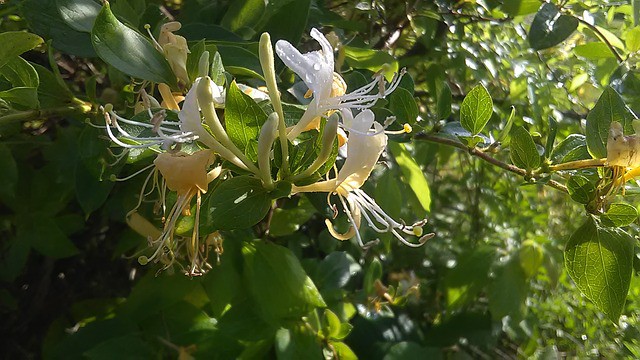The Honeysuckle plant goes woody in a couple of years, this is natural and inevitable. In some cases, Honeysuckle could go woody due to fungal infections. The lower parts of Honeysuckle go woody if the upper parts of the vine overshadow them.
Honeysuckle plants are arching shrubs or twining vines with beautiful flowers. They are a great addition to any garden.
This beautiful plant gives out an almost lemony fragrance from the beautiful white flowers. This scent will stand out in the garden.
Note: Here’s an article that explains why sometimes Honeysuckle fails to flower.
Honeysuckle also has great medicinal properties. It’s used in the treatment of various ailments ranging from digestive disorders to respiratory ailments.
Many times people who grow it face issues. They complain to me in emails that their Honeysuckle has gone woody. In this article, we shall discuss why it turns woody and how to fix it.
Why has my Honeysuckle gone woody?
Honeysuckle plants go woody usually in a couple of years. This is inevitable. It may become brown due to a fungal infection too.
Honeysuckle faces infestations from various insect pests too. Aphids and Scale insects may cause diseases in this plant.
Related: Why Honeysuckle turning yellow?
Old Branches
Honeysuckle branches become woody as the plant grows old. This is just a part of the natural aging process and adaptation to the environment.
This happens because the plant needs to stand upright as the weight of the branches increases. Woody stems help support the structure of the plant.
Woody stems help the plant store more nutrients and water inside the stems.
Pest Infestation
Aphids can be the reason behind woody stems on Honeysuckle. Aphids suck the plant sap through the Honeysuckle branches and turn them woody.
Curling of the foliage is seen in Honeysuckle plants infested by aphids. Aphids hide in the curled-up leaves of Honeysuckle.
Prune off the affected branches as soon as you notice them. You can get rid of Aphids by spraying water on the affected branches of Honeysuckle.
You can get rid of Aphids by applying Neem Oil or Herbicidal oil on the affected parts of the Honeysuckle plant.
How do you prune woody Honeysuckle?
Trim the branch till just before the leaf node. Prune off all the woody parts you see on your Honeysuckle. Cut back any dead/diseased branches on the Honeysuckle.
You can prune the entire vine to the bottom. Trimming the plant down to a few inches above ground has its benefits. If you follow this technique you’ll risk blossom failure the next season.
You can use a saw to do this. If the Honeysuckle grows over a fence, you may want to look at other ways of pruning.
Instead, you can cut a few of the stems back each year. This way you can make sure your plant will blossom. The plant will be in good shape if you do this promptly.
Pruning these old, woody stems is necessary to promote new growth and rejuvenate the plant as a whole. Prune it back hard and keep about 6 inches of stems.
Note: You can plant an evergreen vine to go along with your Honeysuckle. This is to ensure that your woody Honeysuckle doesn’t stand out in your garden. Lavender and Small-leaved ivy grow well together with Honeysuckle. Clematis can be grown with it too.
Sometimes you see that the lower parts of the twining vine go woody. This happens when the top part of the vine overshadows the lower parts.
When to prune Honeysuckle?
You can prune your Honeysuckle in the spring after the flowers fall off the plant. Wait till fall or winter for any hard pruning.
You can trim the vine lightly whenever you want. Overgrown Honeysuckle plant is trimmed back in late winter or early spring.
When to prune Honeysuckle UK
Prune Honeysuckle just after the flowers fall off in the spring. You can prune the Honeysuckle hard in the winter months viz., December, January, and February.
If the pruning is only a little, you can do it any time of the year.
Why does my Honeysuckle look dead?
Did your Honeysuckle go woody? Do you think part of your vine has become old? Does the stem look brown and woody?
This is a common issue with Honeysuckle. These plants look good and healthy for a while, but then suddenly they become woody and gnarled.
Honeysuckle is a twining vine and it does this when growing and spreading. It leaves back old, woody parts of the stem.
Will my Honeysuckle come back?
Yes, you can fix a woody Honeysuckle. You just need to follow good cultural techniques. You can make your Honeysuckle better in no time!
If you are asking if it grows back after pruning, it does. The plant will grow foliage vigorously the next season but doesn’t blossom.
Additional tips
Correct the stems that are growing in undesired directions. You can prune the plant back hard, it will bounce back in spring.
Whenever you see a dead, damaged, or diseased branch of your Honeysuckle, cut it off immediately. It is ideal to have only healthy branches.
Don’t be afraid to cut the plant hard. If the plant is dying, it will rejuvenate if you cut it to a height of 1 foot from the ground.
After pruning the plant do not forget to clear mulch and grass around the base of the tree. This helps prevent weed growth.
If you cut the whole plant hard to the ground, it requires nutrients to bounce back and grow healthier.
You may add fertilizer if you can. Finished compost will work fine too if it is added below a layer of organic mulch.
Happy Growing 🙂

